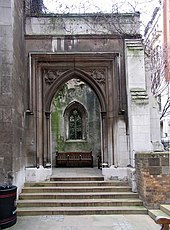St Dunstan-in-the-East
St Dunstan-in-the-East is a former church between St Dunstan's Hill and Idol Lane in the City of London . Christopher Wren's church building was destroyed in the German air raids on London. The ruin and the adjoining churchyard have served as a park since 1971. The ruin is a listed building. It is located in the Eastcheap Conservation Area .
The church is dedicated to Dunstan of Canterbury , the former Archbishop of Canterbury. The name affix "in-the-East" bears the church to distinguish it from St Dunstan-in-the-West , which is on the western edge of the City of London.
Building history
St Dunstan's was originally built in the second half of the 13th century in the Gothic style. The parish belonging to it was one of the richest in London, so that St Dunstan's next to St Magnus the Martyr could pay his priests the highest salaries. The church was extended in 1382 by a southern nave and extensively redesigned in 1633. The resulting building was one of the larger City of London churches, but still significantly smaller than the original medieval structure. The newly clad outer walls survived the Great Fire of London , but the church tower and spire were destroyed.
The steeple was built by Christopher Wren from 1695 to 1701 . The stonemason who carried out the work was Ephraim Beauchamp. Wren had the tower gothic, unusual for his work, in order to adapt it to the rest of the church. It is controversial whether Wren's daughter Jane had any influence on the design. The design is based on St Giles' Cathedral in Edinburgh. According to legend, Wren was so convinced of the shape and stability of the church tower that he considered it to be virtually indestructible. After he was told in 1703 that a tornado had destroyed all the church spiers in the city, he simply replied: "Certainly not those of St Dunstan." The church tower and its top survived the tornado as well as the German air raid.
The church underwent a further redesign from 1817 to 1821. At that time it turned out that the post-fire roof was too heavy for the medieval walls and was slowly pushing them apart. David Laing redesigned the rest of the building, except for the tower, extensively. The church was bombed during the Second World War, but the tower remained intact. Today it houses a center for alternative medicine. The church bells were renewed in 1953. However, they no longer rang, as they might have endangered the stability of the tower standing through the building without a support. During the renovation in 1970, the bells were removed again, and they are now at a Californian winemaker.
After the ruins had stood for a good two decades, the City of London Corporation decided in 1967 to convert the site into a park. The park opened in 1970. In 1976 the landscapers involved won a Landscape Heritage Award for the redesign . The church belongs to the parish of All Hallows-by-the-Tower . Occasionally, open-air services are still held there today, such as on Palm Sunday . Then a procession goes from St Dunstans to All Hallows.
The park
Most of the park is planted with climbing and creeping plants that grow on the church walls. In the protected environment of the ruin, plants grow that are otherwise difficult in the English climate. There is a small fountain in the middle of the nave. The small park is hidden in the middle of the medieval maze of alleys in this part of London. Due to its surprising location and the fact that it is partly in the middle of a ruin, the park appears regularly in insider tip lists and travel guides for London. Nevertheless, on weekdays it is mainly visited by the employees of the surrounding offices, while it is largely deserted on the weekend.
Remarks
- ↑ a b c d e St Dunstan-in-the-East, in: Ben Weinreb, Christopher Hibbert: The London Encyclopedia , Julia Keay, John Keay, 3rd, Macmillan, ISBN 978-1-4050-4924-5 , pp. 755
- ^ A b c Simon Bradley, Nikolaus Pevsner: London 1, The city of London , 1997, London: Penguin. ISBN 978-0-300-09624-8 , pp. 213-214.
- ↑ a b c d St Dunstan's on the All-Hallows-by-the-Tower page
- ↑ The Londonohile: St Dunstan-in-the-East , April 4th 2012
- ↑ a b City of London: St-Dunstan-in-the-East
- ↑ a b c bbc. London | Hidden gardens of the city
literature
- Simon Bradley, Nikolaus Pevsner : London 1, The city of London , 1997, London: Penguin. ISBN 978-0-300-09624-8 , pp. 213-214.
- David Cawley: “The best peal in England”… The last word in every respect. In: The Ringing World. Part 1, Edition 5209, February 25, 2011, pp. 173-177; Part 2, edition 5251/2, December 16, 2011, pp. 1276–1280.
Web links
- St Dunstan's on the side of All-Hallows-by-the-Tower
- City of London: St-Dunstan-in-the-East
- Urban Ghosts: St Dunstan-in-the-East: Bombed-Out Church Re-imagined as Peaceful Urban Garden , January 30, 2013
- Video of St Dunstans
Coordinates: 51 ° 30 '34.9 " N , 0 ° 4' 57.8" W.



